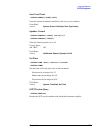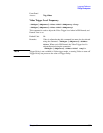
Chapter 5 331
Language Reference
TRACe Subsystem
The purpose of this function is to perform a spatial video averaging as compared to
the temporal version supplied by the video-average command
[:SENSe]:AVERage:TYPE VIDeo. The functions of :TRACe:MATH:SMOoth
<trace> and [:SENSe]:AVERage:TYPE VIDeo|POWer are not
interchangeable.
Each point value is replaced with the average of the values of the selected number
of points, with half of those points located on each side of any particular point
(when possible). Refer to Figure 5-5. This figure illustrates a 401 point trace with a
smoothing number of 31. Think of the trace points as “buckets” of data. To smooth
(arbitrary) point 273, the analyzer averages buckets 258 through 287 and applies
that value to point 273.
Figure 5-5 Smoothing With 401 Trace Points and 31 Smoothing Points
Increasing the number of points increases smoothing at the cost
of decreasing resolution.
The amount of smoothing decreases at the end points. Because
:TRACe:MATH:SMOoth <trace> averages values that occur
before and after the data point in time, display irregularities can
be caused at the start and stop frequencies. To avoid possible
irregularities (signal distortion) at the ends of the trace, use
small values for the smooth parameter.
Refer to Figure 5-5 for a discussion of this end-point smoothing
phenomena. With 31 smoothing points and a 401 point trace,
point 16 will be the first point to have full 31-bucket smoothing.
Likewise, point 385 will be the last point with full 31-bucket
smoothing. Under the conditions stated, points 2 through 15 will
be smoothed as follows: Point 2 is derived from averaging
buckets 1 through 3. Point 3 is derived from averaging buckets 1
through 5, Point 4 is derived from averaging buckets 1 through
7, and so forth until point 16 is reached. The quantity of buckets
used for the smoothing running average increases at the rate of 2
buckets per point, from point 1 to point ([smoothing number/2]


















